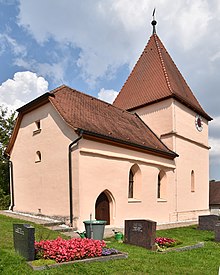St. Martin (Moratneustetten)
St. Martin is an Evangelical Lutheran church named after St. Martin of Tours in Moratneustetten ( Deanery Ansbach ).
Parish
In 1451 the parish of Moratneustetten was first mentioned in a document. At that time it belonged to St. Jakob (Weihenzell) . It is possible that St. Martin formed a parish district to which the places Gödersklingen , Schmalach and Wüstendorf belonged. In 1503 St. Martin was given to the parish of St. Johannes (Wernsbach near Ansbach) . By 1800 at the latest, Moratstetten was again a Weihenzell branch. It currently has around 80 parishioners in Moratneustetten. At least three church services are celebrated each year, as well as baptisms, weddings and funerals.
Church building
St. Martin is a Gothic choir tower church of the 13th / 14th centuries built mainly from ashlar stones . Century. The choir tower to the east has two small pointed arch windows on the south and east sides, a bell-shaped storey that is closed off by a four-sided pyramid roof. The hall building to the west has a half-hipped roof on the west side, two pointed arch windows and the pointed arch portal on the south side, a small round arch and rectangular window directly one above the other on the west side. Both the hall building and the bell storey are said to have originally been higher and were only removed through renovation work. In 1627 a cemetery was laid out around the church. The cemetery wall is considered a former defensive wall and is provided with supporting pillars.
The single-nave hall has a drawn-in flat wooden ceiling with a gallery on the north and west sides. A pointed arch arcade with fighters on the east side connects this with the choir. The choir has a square floor plan and is closed off by a cross vault. There is a Gothic altar hall with a painting from the 19th century above it showing the crucifixion scene with Mary, John and Mary Magdalene. A wooden pulpit with a polygonal basket and sound cover is located to the right of the pointed arch arcade. These, as well as the pews and wooden galleries, probably date from the renovation work in 1865.
A special feature is the first church bell, which was probably made by the Nuremberg bell caster Hermann Kessler II or a successor in the second half of the 14th century. It has a diameter of 43 cm. The inscription reads: "AVE MARIA GRACIA PLENA DOMINVS TECVM BENEDICTATV INMVLIERIBV (S)". The second bell had to be delivered in 1942 and was probably used for war purposes. It was replaced in 1987 by a new bell with a diameter of 70 cm and a weight of four hundred pounds. The inscription reads: "BLESSED ARE THOSE WHO HEAR AND KEEP GOD'S WORD".
Further renovations took place in 1976 and 1992/93.
literature
- Günther P. Fehring : City and district of Ansbach (= Bavarian art monuments . Volume 2 ). Deutscher Kunstverlag, Munich 1958, DNB 451224701 , p. 127-128 .
- Günther Roesner: Weihenzell. History and present of a Middle Franconian village . 2nd, revised edition. Ansbach 1999, p. 84-85 (first edition: 1985).
- Hans Sommer with e. Working group d. Dean's office (ed.): It happened in the name of faith: Protestant in the Ansbach deanery (= series of portraits of Bavarian deanery districts ). Verlag der Evangelisch-Lutherischen Mission, Erlangen 1991, ISBN 3-87214-248-8 , p. 156-157 .
Web links
- St. Martin on the website www.moratneustetten.de of the village community Moratneustetten e. V.
Individual evidence
- ↑ Manfred Jehle: Church conditions and religious institutions on the upper Altmühl, Rezat and Bibert: Monasteries, parishes and Jewish communities in the Altlandkreis Ansbach in the Middle Ages and in the modern era (= Middle Franconian Studies . Volume 20 ). Historical Association for Middle Franconia, Ansbach 2009, ISBN 978-3-87707-771-9 , p. 292 .
- ↑ a b St. Martin on the website www.moratneustetten.de of the village community Moratneustetten e. V.
- ↑ H. Sommer (Ed.), P. 156; G. Roesner, p. 84.
- ↑ GP Fehring, p. 127f.
Coordinates: 49 ° 22 '30.7 " N , 10 ° 35' 43.9" E

